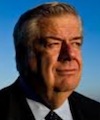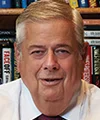|
|
“The more you practice the art of thankfulness, the more you have to be thankful for.”
--Norman Vincent Peale
In a few days we will celebrate Thanksgiving 2018 and the start of the holiday season.
America continues to face challenges on many fronts, both at home and abroad, but there is much to be thankful for as we come together to celebrate each other and our communities.
Consider offering thanks to:
- The hundreds of thousands of men and women who serve in our Armed Forces and who work every day—many in extremely dangerous circumstances—to ensure our safety and make this holiday possible;
- Our extraordinary police officers and firefighters, who protect us at every turn;
- The legions of emergency workers who toil night and day in our nation and the around the world—obviously recently in California, New York and the Southeast;
- The unsung volunteers who work every day to lift up those of us who need it most;
- The thousands of educators who work for modest pay to prepare our young people for the future.
We owe all these people—and many more like them—a lot. Taken together with the generosity of the American people, they are what constitute our national character.
Now, some facts about Thanksgiving:
- Thanksgiving is celebrated every year on the fourth Thursday in November. The first Thanksgiving was celebrated by the Pilgrims in 1621. It was not celebrated again for 55 years. President George Washington proclaimed Thursday, November 26, 1789, as a day of “public thanksgiving and prayer,” establishing a non-sectarian tone for the day and stressing the political and moral blessings that make American self-government possible.
- New York adopted a day of Thanksgiving in 1817 as an annual celebration, and in 1863 President Abraham Lincoln designated a national day of Thanksgiving. This year marks the 155th anniversary of Lincoln's Proclamation.
- Among the foods served at that first Thanksgiving in 1621 were waterfowl, venison, fish, lobster, clams, berries, fruit, pumpkin, and squash.
- Although the concept of Thanksgiving developed in the colonies of New England, its roots originate on the other side of the Atlantic. Both the Separatists and the Puritans brought with them a tradition of providential holidays—days of fasting during pivotal times and days of feasting and celebration in times of plenty.
- The most widely known celebration of Thanksgiving is that of the Pilgrims in Plymouth, MA, who dined for three days with the Wampanoag people, but the first national holiday of Thanksgiving was observed to honor the creation of the new Constitution.
- Canadian Thanksgiving is celebrated on the second Monday in October, marking the meal English explorer Martin Frobisher and his crew held to thank God for safe passage in the New World.
- Turkey became the traditional Thanksgiving food because it was once considered a rare treat that cost a day’s wages. They remain the symbol of bounty and thanksgiving today—in fact, astronauts Armstrong and Aldrin ate roast turkey for their first meal on the Moon.
- Sarah Josepha Hale, an influential magazine editor and author, petitioned for a national Thanksgiving holiday for close to 40 years, believing that “Thanksgiving, like the Fourth of July, should be considered a national festival and observed by all our people.” She was also the author of the classic nursery rhyme “Mary Had a Little Lamb.”
- In 1953, someone at Swanson misjudged the number of frozen turkeys it would sell that Thanksgiving and remedied the problem by slicing up the meat and packaging it with trimmings on the side, resulting in the invention of what we know now as the TV dinner.
- And this “important fact”—Weather folklore holds that turkeys perched on trees and refusing to descend indicates snow.
Thanksgiving. We all have much to be thankful for.
Enjoy the day and the start of the holiday season.
***
Robert L. Dilenschneider is founder and chairman of The Dilenschneider Group, a global public relations and communications consulting firm headquartered in New York City. The former CEO of Hill and Knowlton, Inc., he is also author of more than a dozen books, including the best-selling “Power and Influence.”

 Robert L. Dilenschneider
Robert L. Dilenschneider
 The ridiculously high prices Americans are paying at the supermarket might influence how—or if—they vote in November.
The ridiculously high prices Americans are paying at the supermarket might influence how—or if—they vote in November. At a moment in history when there are so many conflicts among peoples here and abroad, let us put our differences aside and celebrate this wonderful season in a spirit of togetherness.
At a moment in history when there are so many conflicts among peoples here and abroad, let us put our differences aside and celebrate this wonderful season in a spirit of togetherness. The news announcing the death of Henry Kissinger, the last of the prevaricating politicians and so-called statesmen who stole my future and that of thousands of other young Americans, got me thinking about Walter Cronkite.
The news announcing the death of Henry Kissinger, the last of the prevaricating politicians and so-called statesmen who stole my future and that of thousands of other young Americans, got me thinking about Walter Cronkite.


 Have a comment? Send it to
Have a comment? Send it to 
No comments have been submitted for this story yet.